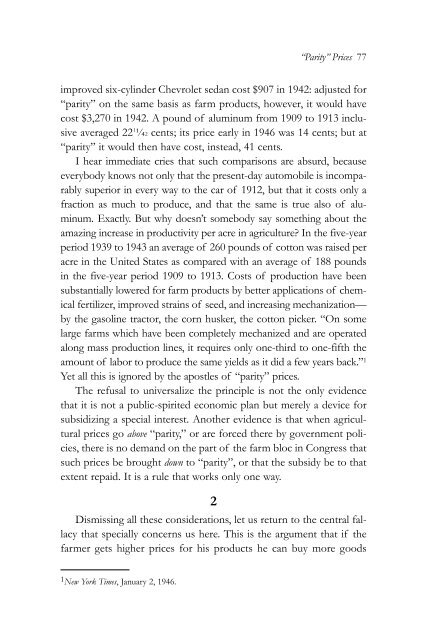1gDdM7w
1gDdM7w
1gDdM7w
- No tags were found...
Create successful ePaper yourself
Turn your PDF publications into a flip-book with our unique Google optimized e-Paper software.
“Parity” Prices 77improved six-cylinder Chevrolet sedan cost $907 in 1942: adjusted for“parity” on the same basis as farm products, however, it would havecost $3,270 in 1942. A pound of aluminum from 1909 to 1913 inclusiveaveraged 22 1 ¼2 cents; its price early in 1946 was 14 cents; but at“parity” it would then have cost, instead, 41 cents.I hear immediate cries that such comparisons are absurd, becauseeverybody knows not only that the present-day automobile is incomparablysuperior in every way to the car of 1912, but that it costs only afraction as much to produce, and that the same is true also of aluminum.Exactly. But why doesn’t somebody say something about theamazing increase in productivity per acre in agriculture? In the five-yearperiod 1939 to 1943 an average of 260 pounds of cotton was raised peracre in the United States as compared with an average of 188 poundsin the five-year period 1909 to 1913. Costs of production have beensubstantially lowered for farm products by better applications of chemicalfertilizer, improved strains of seed, and increasing mechanization—by the gasoline tractor, the corn husker, the cotton picker. “On somelarge farms which have been completely mechanized and are operatedalong mass production lines, it requires only one-third to one-fifth theamount of labor to produce the same yields as it did a few years back.” 1Yet all this is ignored by the apostles of “parity” prices.The refusal to universalize the principle is not the only evidencethat it is not a public-spirited economic plan but merely a device forsubsidizing a special interest. Another evidence is that when agriculturalprices go above “parity,” or are forced there by government policies,there is no demand on the part of the farm bloc in Congress thatsuch prices be brought down to “parity”, or that the subsidy be to thatextent repaid. It is a rule that works only one way.2Dismissing all these considerations, let us return to the central fallacythat specially concerns us here. This is the argument that if thefarmer gets higher prices for his products he can buy more goods1 New York Times, January 2, 1946.


